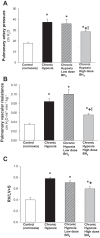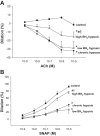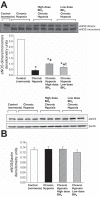Tetrahydrobiopterin oral therapy recouples eNOS and ameliorates chronic hypoxia-induced pulmonary hypertension in newborn pigs
- PMID: 27542807
- PMCID: PMC5142125
- DOI: 10.1152/ajplung.00238.2016
Tetrahydrobiopterin oral therapy recouples eNOS and ameliorates chronic hypoxia-induced pulmonary hypertension in newborn pigs
Abstract
We previously showed that newborn piglets who develop pulmonary hypertension during exposure to chronic hypoxia have diminished pulmonary vascular nitric oxide (NO) production and evidence of endothelial NO synthase (eNOS) uncoupling (Fike CD, Dikalova A, Kaplowitz MR, Cunningham G, Summar M, Aschner JL. Am J Respir Cell Mol Biol 53: 255-264, 2015). Tetrahydrobiopterin (BH4) is a cofactor that promotes eNOS coupling. Current clinical strategies typically invoke initiating treatment after the diagnosis of pulmonary hypertension, rather than prophylactically. The major purpose of this study was to determine whether starting treatment with an oral BH4 compound, sapropterin dihydrochloride (sapropterin), after the onset of pulmonary hypertension would recouple eNOS in the pulmonary vasculature and ameliorate disease progression in chronically hypoxic piglets. Normoxic (control) and hypoxic piglets were studied. Some hypoxic piglets received oral sapropterin starting on day 3 of hypoxia and continued throughout an additional 7 days of hypoxic exposure. Catheters were placed for hemodynamic measurements, and pulmonary arteries were dissected to assess eNOS dimer-to-monomer ratios (a measure of eNOS coupling), NO production, and superoxide (O2·-) generation. Although higher than in normoxic controls, pulmonary vascular resistance was lower in sapropterin-treated hypoxic piglets than in untreated hypoxic piglets. Consistent with eNOS recoupling, eNOS dimer-to-monomer ratios and NO production were greater and O2·- generation was less in pulmonary arteries from sapropterin-treated than untreated hypoxic animals. When started after disease onset, oral sapropterin treatment inhibits chronic hypoxia-induced pulmonary hypertension at least in part by recoupling eNOS in the pulmonary vasculature of newborn piglets. Rescue treatment with sapropterin may be an effective strategy to inhibit further development of pulmonary hypertension in newborn infants suffering from chronic cardiopulmonary conditions associated with episodes of prolonged hypoxia.
Keywords: nitric oxide signaling; pulmonary resistance arteries; sapropterin dihydrochloride; superoxide.
Copyright © 2016 the American Physiological Society.
Figures







Similar articles
-
Combined l-citrulline and tetrahydrobiopterin therapy improves NO signaling and ameliorates chronic hypoxia-induced pulmonary hypertension in newborn pigs.Am J Physiol Lung Cell Mol Physiol. 2020 Apr 1;318(4):L762-L772. doi: 10.1152/ajplung.00280.2019. Epub 2020 Feb 19. Am J Physiol Lung Cell Mol Physiol. 2020. PMID: 32073878 Free PMC article.
-
Rescue Treatment with L-Citrulline Inhibits Hypoxia-Induced Pulmonary Hypertension in Newborn Pigs.Am J Respir Cell Mol Biol. 2015 Aug;53(2):255-64. doi: 10.1165/rcmb.2014-0351OC. Am J Respir Cell Mol Biol. 2015. PMID: 25536367 Free PMC article.
-
Folic Acid Promotes Recycling of Tetrahydrobiopterin and Protects Against Hypoxia-Induced Pulmonary Hypertension by Recoupling Endothelial Nitric Oxide Synthase.Antioxid Redox Signal. 2015 Nov 10;23(14):1076-91. doi: 10.1089/ars.2015.6329. Epub 2015 Nov 5. Antioxid Redox Signal. 2015. PMID: 26414244 Free PMC article.
-
Tetrahydrobiopterin regulation of eNOS redox function.Curr Pharm Des. 2014;20(22):3554-62. doi: 10.2174/13816128113196660747. Curr Pharm Des. 2014. PMID: 24180387 Review.
-
Pathogenetic role of eNOS uncoupling in cardiopulmonary disorders.Free Radic Biol Med. 2011 Apr 1;50(7):765-76. doi: 10.1016/j.freeradbiomed.2010.12.018. Epub 2010 Dec 21. Free Radic Biol Med. 2011. PMID: 21172428 Review.
Cited by
-
Altered metabolites in newborns with persistent pulmonary hypertension.Pediatr Res. 2018 Aug;84(2):272-278. doi: 10.1038/s41390-018-0023-y. Epub 2018 Jun 12. Pediatr Res. 2018. PMID: 29895840 Free PMC article.
-
Endothelial Dysfunction Driven by Hypoxia-The Influence of Oxygen Deficiency on NO Bioavailability.Biomolecules. 2021 Jul 3;11(7):982. doi: 10.3390/biom11070982. Biomolecules. 2021. PMID: 34356605 Free PMC article. Review.
-
Nitric oxide and hydrogen sulfide: the gasotransmitter paradigm of the vascular system.Br J Pharmacol. 2017 Nov;174(22):4021-4031. doi: 10.1111/bph.13815. Epub 2017 May 16. Br J Pharmacol. 2017. PMID: 28407204 Free PMC article. Review.
-
Protein arginine methyltransferase 4 modulates nitric oxide synthase uncoupling and cerebral blood flow in Alzheimer's disease.J Cell Physiol. 2024 Jun;239(6):e30858. doi: 10.1002/jcp.30858. Epub 2022 Aug 29. J Cell Physiol. 2024. PMID: 36036549 Free PMC article.
-
Amorphous nano-selenium quantum dots prevent pulmonary arterial hypertension through recoupling endothelial nitric oxide synthase.Aging (Albany NY). 2020 Dec 15;13(3):3368-3385. doi: 10.18632/aging.202215. Epub 2020 Dec 15. Aging (Albany NY). 2020. PMID: 33323558 Free PMC article.
References
-
- Banks BA, Seri I, Ischiropoulos H, Merrill J, Rychik J, Ballard RA. Changes in oxygenation with inhaled nitric oxide in severe bronchopulmonary dysplasia. Pediatrics 103: 610–618, 1999. - PubMed
-
- Brennan LA, Steinhorn RH, Wedgwood S, Mata-Greenwood E, Roark EA, Russell JA, Black SM. Increased superoxide generation is associated with pulmonary hypertension in fetal lambs: a role for NADPH oxidase. Circ Res 92: 683–691, 2003. - PubMed
MeSH terms
Substances
Grants and funding
LinkOut - more resources
Full Text Sources
Other Literature Sources
Medical

